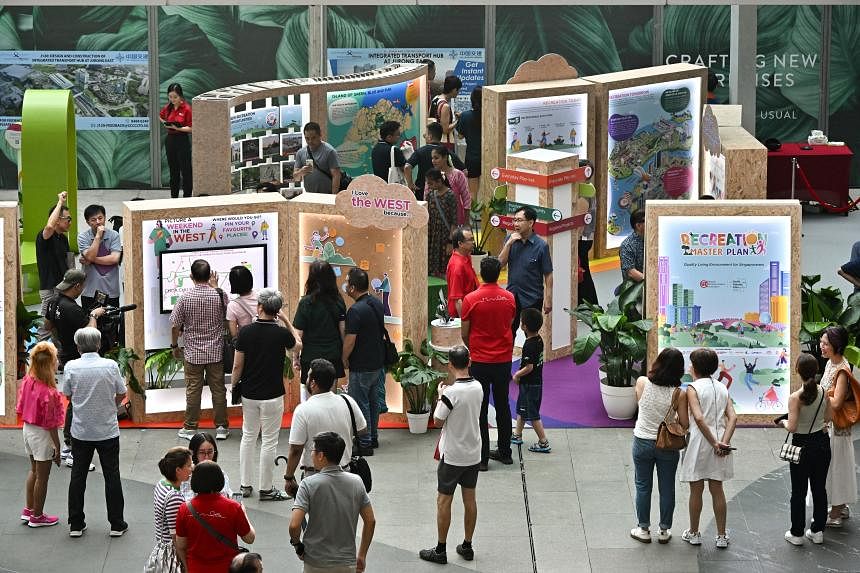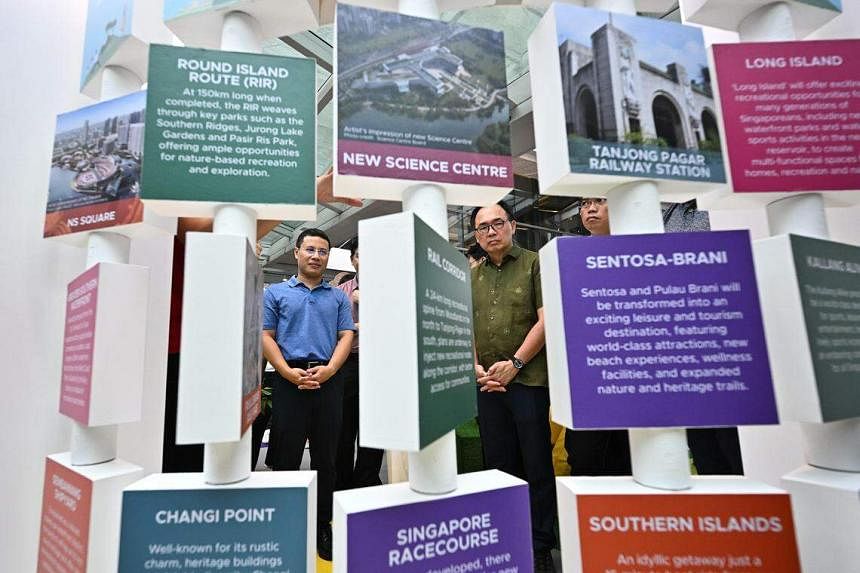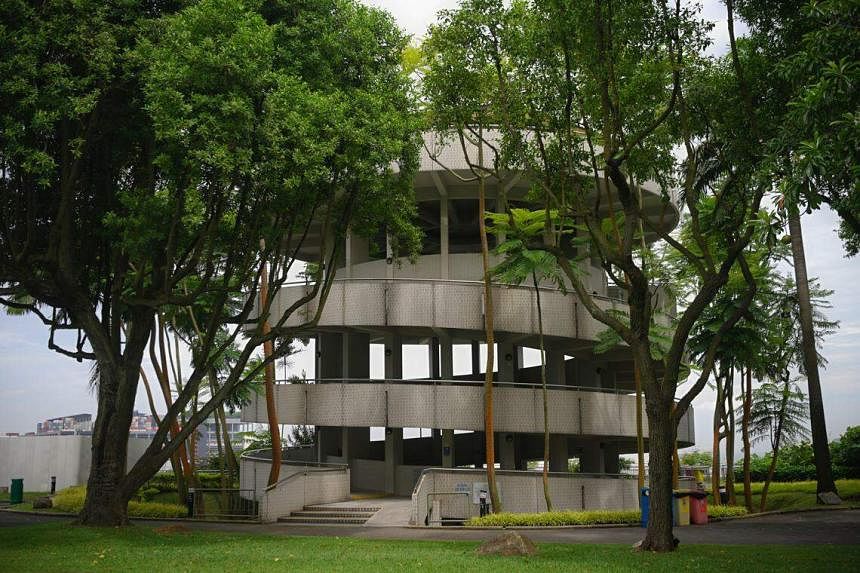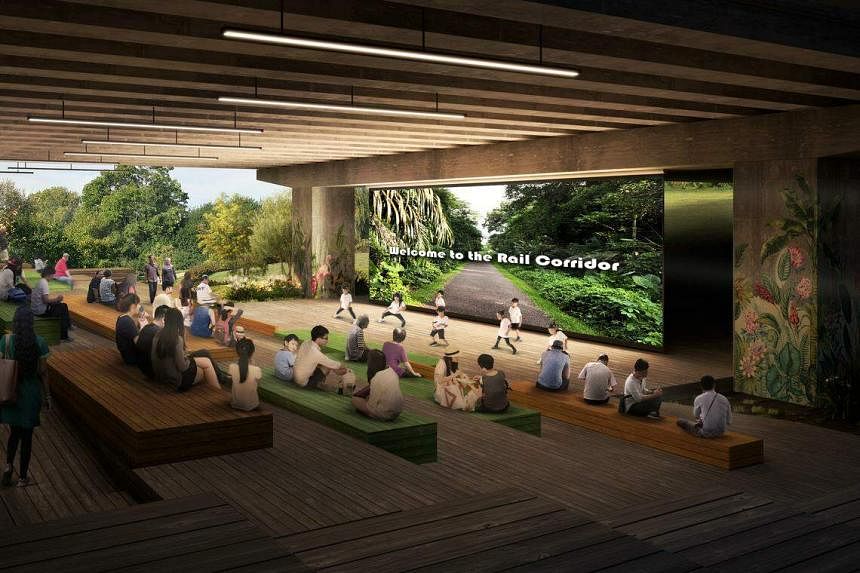This ish call listen to people mah...why complain again. This are good people who 为国为民Paid millions and hundreds of thousands to organise and solicit ideas. And then take the credit for ideas that work.
URA to gather public views on land use strategies for long-term plans

The URA is starting the second phase of its public engagement exercise, as part of a review of its long-term plans.
ST PHOTO: LIM YAOHUI

Sue-Ann Tan
Oct 11, 2021
SINGAPORE - From this month, members of the public can contribute their views on how Singapore can use its land in the long term in six virtual discussion sessions held by the Urban Redevelopment Authority (URA).
The URA said on Monday (Oct 11) that it is starting the second phase of its public engagement exercise, as part of a review of its long-term plans.
Previously known as the Concept Plan, the long-term plans will guide development over the next 50 years and beyond. They are reviewed every decade to take into account evolving trends and changing demands.
As part of the second phase, the URA boiled down the desired traits for the Singapore of the future to four key pillars - inclusive, adaptable and resilient, sustainable, and distinctive and endearing.
An inclusive Singapore means designing future neighbourhoods with a variety of quality and affordable housing for different demographics of residents, the URA said.
It also means better distribution of amenities and job opportunities near homes, with improved accessibility and mobility.
"It is important to ensure that our land use plans and our urban infrastructure provide spaces for everyone, and strengthen social inclusiveness and cohesion," said the authority.
Meanwhile, to build an adaptable and resilient Singapore, future workplaces and homes need to be designed, taking into account emerging economic and technological trends, especially in the light of the impact of Covid-19, the URA added.
The land use plans need to allow Singapore to respond to an increasingly complex and uncertain operating environment, while seizing future opportunities, it said.
Sustainability is also key, as Singapore has to find ways to optimise its limited resources and care for the environment, while addressing its needs.
"Possible land use strategies to balance development with nature, close our resource loops, advance our green economy, and support sustainable infrastructure will also be discussed," the URA said.
It noted that long-term liveability is important, especially with climate change. The land use plans need to ensure sustainability while balancing environmental, economic and social goals with limited land resources.
Lastly, Singapore has to be "distinctive and endearing", said the authority.
"Our city centre is also an important economic, cultural and social node that positions Singapore as a global hub," it said.
"Our land use plans need to strengthen Singapore's position as a distinctive destination and endearing home to ensure Singapore remains attractive to businesses and tourists while maintaining a strong sense of identity and familiarity among residents."
These plans will centre on ways to retain and celebrate Singapore's built and natural heritage, and enhance recreational areas and attractions.
This can also mean strategies to rejuvenate the city centre and the Central Business District.
The six virtual sessions to discuss the URA's plans will be held from Oct 24 to Dec 4.
The previous phase was held from July to September, during which more than 5,600 people responded to a public poll and some 200 people participated in workshops and dialogues.
The public can sign up for any of the sessions at this website.
-
IP addresses are NOT logged in this forum so there's no point asking. Please note that this forum is full of homophobes, racists, lunatics, schizophrenics & absolute nut jobs with a smattering of geniuses, Chinese chauvinists, Moderate Muslims and last but not least a couple of "know-it-alls" constantly sprouting their dubious wisdom. If you believe that content generated by unsavory characters might cause you offense PLEASE LEAVE NOW! Sammyboy Admin and Staff are not responsible for your hurt feelings should you choose to read any of the content here. The OTHER forum is HERE so please stop asking.
You are using an out of date browser. It may not display this or other websites correctly.
You should upgrade or use an alternative browser.
You should upgrade or use an alternative browser.
Highly-paid ministers and civil servants ask you to think for them
- Thread starter LITTLEREDDOT
- Start date
So many hundreds of thousands locals asked them to revoke the CECA agreement and repatriate the faked CECA Indians talents, did they hear and listen? Any action?This ish call listen to people mah...why complain again. This are good people who 为国为民
It will be better for them to send us their grand plan. Then from there we can comment and build on. Peasant does not know what government want.Paid millions and hundreds of thousands to organise and solicit ideas. And then take the credit for ideas that work.
URA to gather public views on land use strategies for long-term plans

The URA is starting the second phase of its public engagement exercise, as part of a review of its long-term plans.
ST PHOTO: LIM YAOHUI

Sue-Ann Tan
Oct 11, 2021
SINGAPORE - From this month, members of the public can contribute their views on how Singapore can use its land in the long term in six virtual discussion sessions held by the Urban Redevelopment Authority (URA).
The URA said on Monday (Oct 11) that it is starting the second phase of its public engagement exercise, as part of a review of its long-term plans.
Previously known as the Concept Plan, the long-term plans will guide development over the next 50 years and beyond. They are reviewed every decade to take into account evolving trends and changing demands.
As part of the second phase, the URA boiled down the desired traits for the Singapore of the future to four key pillars - inclusive, adaptable and resilient, sustainable, and distinctive and endearing.
An inclusive Singapore means designing future neighbourhoods with a variety of quality and affordable housing for different demographics of residents, the URA said.
It also means better distribution of amenities and job opportunities near homes, with improved accessibility and mobility.
"It is important to ensure that our land use plans and our urban infrastructure provide spaces for everyone, and strengthen social inclusiveness and cohesion," said the authority.
Meanwhile, to build an adaptable and resilient Singapore, future workplaces and homes need to be designed, taking into account emerging economic and technological trends, especially in the light of the impact of Covid-19, the URA added.
The land use plans need to allow Singapore to respond to an increasingly complex and uncertain operating environment, while seizing future opportunities, it said.
Sustainability is also key, as Singapore has to find ways to optimise its limited resources and care for the environment, while addressing its needs.
"Possible land use strategies to balance development with nature, close our resource loops, advance our green economy, and support sustainable infrastructure will also be discussed," the URA said.
It noted that long-term liveability is important, especially with climate change. The land use plans need to ensure sustainability while balancing environmental, economic and social goals with limited land resources.
Lastly, Singapore has to be "distinctive and endearing", said the authority.
"Our city centre is also an important economic, cultural and social node that positions Singapore as a global hub," it said.
"Our land use plans need to strengthen Singapore's position as a distinctive destination and endearing home to ensure Singapore remains attractive to businesses and tourists while maintaining a strong sense of identity and familiarity among residents."
These plans will centre on ways to retain and celebrate Singapore's built and natural heritage, and enhance recreational areas and attractions.
This can also mean strategies to rejuvenate the city centre and the Central Business District.
The six virtual sessions to discuss the URA's plans will be held from Oct 24 to Dec 4.
The previous phase was held from July to September, during which more than 5,600 people responded to a public poll and some 200 people participated in workshops and dialogues.
The public can sign up for any of the sessions at this website.
Just like simplygo, aligning of payment system also created so much issue.
These are the "foreign talents" that our Govt has brought into S'pore

Our politicians are so blinded by greed that they cannot see the big picture behind

Study Taiwan’s EasyCard system
January 26, 2024I refer to the report “LTA shelves plan to replace older public transport payment cards with SimplyGo by June” (Jan 22). Transport Minister Chee Hong Tat cited London and Hong Kong’s use of account-based transit cards that do not display fare deductions and card balances.
Taiwan’s EasyCard is also linked to an app where people can top up their cards online, check their travel history and de-link the card to protect their card balance in case of loss. Card deductions and balances are also displayed on fare readers. The EasyCard can last 20 years, as opposed to the ez-link card’s five years.
The authorities should study this account-based system and improve the lifespan of physical cards rolled out in the future. This would address commuters’ concerns over correct fare deductions and low card balances, and reduce plastic waste and administrative work that come with card replacement.
Elsa Wan
Wanted: Recreation ideas for Turf Club, Sembawang Shipyard, old bird park sites

The Recreation Master Plan roving exhibition at Westgate in Jurong East on April 14. ST PHOTO: LIM YAOHUI

Ng Keng Gene
Correspondent
APR 15, 2024
SINGAPORE – Sembawang Shipyard, the former Jurong Bird Park, and the Singapore Turf Club in Kranji are among existing and future development sites that the authorities are seeking public ideas for as part of the Urban Redevelopment Authority’s (URA) upcoming Recreation Master Plan.
The recreation plan will be one aspect of the URA’s next draft masterplan, which will be unveiled in 2025. The latter plan – a statutory document – guides Singapore’s development over the next 10 to 15 years, and is reviewed every five years.
On April 14, National Development Minister Desmond Lee launched the Recreation Master Plan roving exhibition at Westgate in Jurong East. The exhibition showcases recent recreation-focused proposals and developments that were put together based on aspirations for recreational amenities canvassed from Singaporeans.
In a speech, Mr Lee said that the authorities have intentionally planned for recreational spaces over the years.
For instance, a blueprint for green and blue spaces that was part of the 1991 Concept Plan was expanded into the Leisure Plan 2008, which guided the development of the Round Island Route, the Southern Ridges, and improvements to Sungei Buloh Wetland Reserve.
Mr Lee, who is also minister-in-charge of social services integration, noted that the Covid-19 pandemic underscored the importance of recreational spaces to Singaporeans, and added that amid increasing land pressures, recreation and well-being must continue to be prioritised.
In preparing for the Recreation Master Plan, URA in 2022 commissioned an independent research agency to survey 3,000 Singaporeans aged 16 and above on their preferences for recreation. The survey respondents were representative of Singapore’s demographics in terms of age, gender and ethnicity.

National Development Minister Desmond Lee (left) viewing a display on the various projects that URA is seeking feedback on at Westgate on April 14. With him were various MPs, including Mr Liang Eng Hwa (right). ST PHOTO: LIM YAOHUI
URA said that dining out, shopping and cardiovascular exercises such as running and jogging were among the top recreational activities among those surveyed, while affordability and proximity from home, work and transport nodes were among their top considerations when it came to choosing recreational options.
Public feedback for the plan is being sought across three areas.
First, the authorities want to further tap the recreational potential of the country’s green and blue spaces – referring to greenery as well as water bodies and coastal areas. These include existing sites such as Pulau Ubin, Changi Point, and the Sentosa and Pulau Brani islands, as well as upcoming development areas such as Sembawang Shipyard, the Long Island project, Paya Lebar Air Base and the Singapore Turf Club in Kranji.
The shipyard, for instance, is slated to be redeveloped as a mixed-use waterfront precinct when shipyard operations cease – offering recreational opportunities that capitalise on its waterfront location.
Mr Lee added that later in 2024, URA and JTC Corporation will hold an ideas competition for Jurong Hill and the former Jurong Bird Park, focusing on how their lush greenery can be integrated with surrounding built-up areas.

An ideas competition will be launched later in 2024 for the former Jurong Bird Park and Jurong Hill (its observatory tower that opened in 1970 pictured). PHOTO: ST FILE
Second, ideas are also being solicited for ways to convert underutilised spaces for recreation, along the lines of the upcoming community space for the Rail Corridor sited under a Queensway viaduct.

An artist’s impression of the upcoming community space in the Rail Corridor’s Queensway node. PHOTO: HDB
Third, the authorities are seeking ways to make recreational spaces more inclusive for all, including the elderly and people with disabilities.
Recent efforts on this front include Punggol Regional Library, which – among other features for people with disabilities – has wheelchair-accessible book borrowing stations, Braille books and assistive technology like high contrast keyboards for the visually impaired.
URA said that at each stop of the roving exhibition, residents will be invited to provide feedback, and – where relevant – be invited to sign up for focused engagements.
For the stops in the west, input will be sought for projects such as the new Science Centre, Pandan Reservoir and the Old Jurong Line Nature Trail.
Also wanted are ideas for how the existing Science Centre Singapore can be repurposed after the centre relocates in end-2027.
URA chief executive Lim Eng Hwee said: “Recreation is not just about leisure and fun, but is a key ingredient to support residents’ well-being, strengthen social bonds as well as improve the quality of life in our city-state.
“We are therefore committed to creating the Recreation Master Plan with Singaporeans while balancing our wide spectrum of land use needs, to build stronger communities and make Singapore a more liveable, sustainable and endearing home for all.”
Mr Michael Lee, a Jurong East resident of more than 20 years, said the exhibition gave him a clearer idea about upcoming plans for the area, such as specific amenities in the upcoming Jurong East Integrated Transport Hub.
“It’s good to be able to give feedback, but even better if the authorities are able to take on suggestions,” said the 74-year-old retiree, who previously worked in information technology in the petrochemical sector.
Another Jurong resident who gave her name only as Ms Chia and is expecting her first child in June said she learnt about the new Science Centre – slated to open in the Jurong Lake District in 2027 – through the exhibition, and was looking forward to visiting it with her family in the future.
“Although Singapore is generally well-planned, I appreciate that Singaporeans’ inputs are still sought for upcoming developments,” said the 30-year-old marketing manager.
To provide feedback and find out more about the Recreation Master Plan, visit go.gov.sg/Recreation
Recreation Master Plan roving exhibition stops
- Westgate (April 14 to 19, 2024)
- Senja-Cashew Community Club (April 21 to 28, 2024)
- Bedok Town Square (May 11 to 19, 2024)
- VivoCity (May 21 to June 2, 2024)
- Kallang Wave Mall (June 8 to 16, 2024)
- One Punggol (June 22 to 30, 2024)
- Canberra Plaza (July 6 to 14, 2024)
- The URA Centre (July 18 to 27, 2024; closed on Sundays)
Similar threads
- Replies
- 3
- Views
- 458
- Replies
- 0
- Views
- 446
- Replies
- 0
- Views
- 441
- Replies
- 8
- Views
- 819
- Replies
- 4
- Views
- 654
